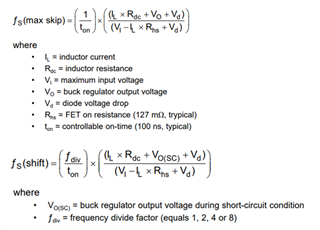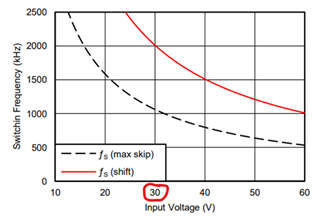Tool/software:
I'm attempting to calculate the max switching frequency for my application using equations 4 and 5 from the datasheet (pg. 14).

Question:
- Given that equation 5 only applies during a short-circuit event, what values for the inductor current and the diode forward voltage should be used? It makes sense to the typical values for my application in equation 4, but not equation 5. Should it be the max current that can flow into VIN and the diode voltage drop at that current?
- If I use all the example values given in Section 7.3.1.12 of the datasheet my calculated frequencies (fs(max skip) and fs(shift)) do not match Figure 9. Here are the input values I used and my calculated frequencies at Input Voltage = 30V:
| IL (A) | 1 |
| Rdc (Ohm) | 0.13 |
| VI (V) | 30 |
| VO (V) | 3.3 |
| Vd (V) | 0.5 |
| Rhs (Ohm) | 0.127 |
| ton (sec) | 0.0000001 |
| VO(SC) (V) | 0 |
| fdiv | 8 |
| fs(max skip) (kHz) | 1293.912 |
| fs(shift) (kHz) | 1659.369 |
This doesn't match Figure 9 at Input Voltage = 30V, fs(max skip) ~ 1050kHz and fs(shift) ~ 2000kHz

Am I doing the calculation wrong or is the figure in the datasheet incorrect?

